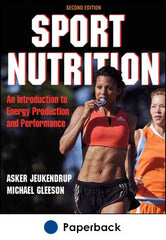Normal ranges of body weight and body fat
This is an excerpt from Sport Nutrition-2nd Edition by Asker Jeukendrup & Michael Gleeson.
Body fat consists of essential body fat and storage fat. Essential body fat is present in the nerve tissues, bone marrow, and organs (all membranes), and we cannot lose this fat without compromising physiological function. Storage fat, on the other hand, represents an energy reserve that accumulates when excess energy is ingested and decreases when more energy is expended than consumed. Essential body fat is approximately 3% of body mass for men and 12% of body mass for women. Women are believed to have more essential body fat than men because of childbearing and hormonal functions. In general, the total body fat percentage (essential plus storage fat) is between 12% and 15% for young men and between 25% and 28% for young women {Lohman, 1993 #4151} (see also table 13.1). Average percentages body fat for the general population and for various athletes are presented in table 13.2.
Table 13.1 Body fat percentages for males and females and their classification
|
Males |
Females |
Rating |
|
5-10 |
8-15 |
Athletic |
|
11-14 |
16-23 |
Good |
|
15-20 |
24-30 |
Acceptable |
|
21-24 |
31-36 |
Overweight |
|
>24 |
>37 |
Obese |
Please keep in mind that these are only rough estimates. The term athletic in this context refers to sports where low body fat is an advantage.
Different sports have different requirements in terms of body composition. In some contact sports such as American football or rugby, a higher body weight is generally seen as an advantage. In sports such as gymnastics, marathon running, and other weight-bearing activities, a lower body weight and high power-to-weight ratio are extremely important. Therefore, in these sports both low body fat and low body weight are necessary. In sports such as bodybuilding, increasing lean-body mass and increasing body weight without increasing body fat are desirable. No accepted percentage body fat standards exist for athletes. The ideal body composition is highly dependent on the particular sport or discipline and should be discussed on an individual basis with the coach, physiologist, and nutritionist or dietician. Body weight and body composition should be discussed in relation to functional capacity and exercise performance.
Table 13.2A Body fat percentage for the average population
|
Age |
Up to 30 |
30-50 |
50+ |
|
Females |
14-21% |
15-23% |
16-25% |
|
Males |
9-15% |
11-17% |
12-19% |
Table 13.2B Body fat percentage for the athletic population
|
Sport |
Male |
Female |
Sport |
Male |
Female |
|
Baseball |
12-15% |
12-18% |
Rowing |
6-14% |
12-18% |
|
Basketball |
6-12% |
20-27% |
Shot Putters |
16-20% |
20-28% |
|
Body building |
5-8% |
10-15% |
Skiing (X country) |
7-12% |
16-22% |
|
Cycling |
5-15% |
15-20% |
Sprinters |
8-10% |
12-20% |
|
Football (Backs) |
9-12% |
No data |
Soccer |
10-18% |
13-18% |
|
Football (Linemen) |
15-19% |
No data |
Swimming |
9-12% |
14-24% |
|
Gymnastics |
5-12% |
10-16% |
Tennis |
12-16% |
16-24% |
|
High/long Jumpers |
7-12% |
10-18% |
Triathlon |
5-12% |
10-15% |
|
Ice/field Hockey |
8-15% |
12-18% |
Volleyball |
11-14% |
16-25% |
|
Marathon running |
5-11% |
10-15% |
Weightlifters |
9-16% |
No data |
|
Racquetball |
8-13% |
15-22% |
Wrestlers |
5-16% |
No data |
Learn more about Sport Nutrition, Second Edition.
More Excerpts From Sport Nutrition-2nd Edition

Get the latest insights with regular newsletters, plus periodic product information and special insider offers.
JOIN NOW
Latest Posts
- Sample mental health lesson plan of a skills-based approach
- Sample assessment worksheet for the skill of accessing valid and reliable resources
- Help your students overcome what holds them back from making health-promoting choices
- Example of an off-season microcycle
- Modifying lifts
- Screening for multilevel programs in a team environment


